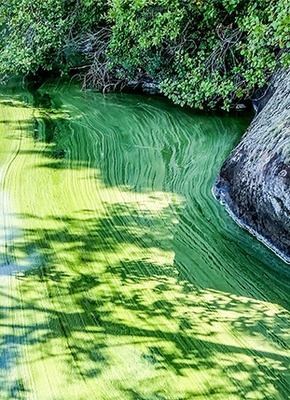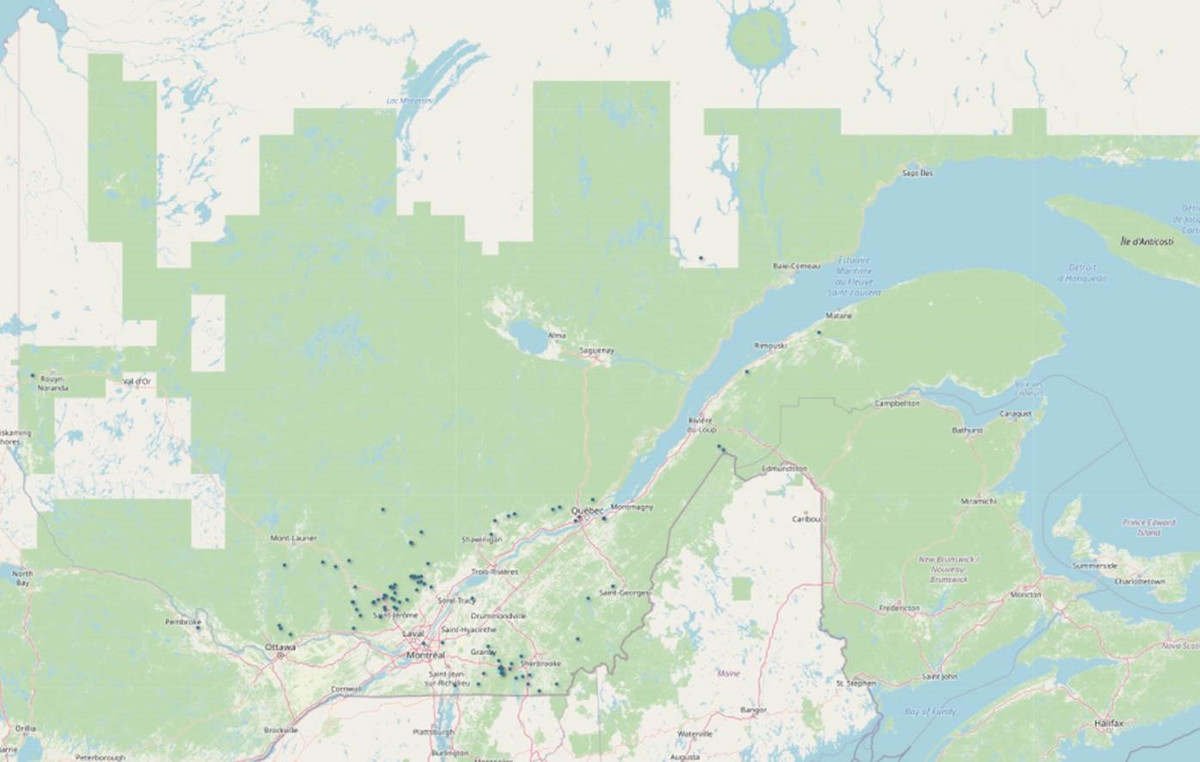
Photo credit : Polytechnique Montréal
The UdeM is involved in a citizen campaign of over $100,000 to preserve lakes from blue-green algae.
Background
For a number of years now, the development of blue-green algae has been an environmental problem that has alarmed health authorities, as well as many citizens, elected officials and business people throughout Quebec and Canada.
What are blue-green algae?
Also known as cyanobacteria, blue-green algae are bacteria that naturally occur in waterways. At a certain level of heat (a phenomenon exacerbated by climate change), light and nutrients (from agriculture or municipal discharges), the bacteria proliferate and flourish in aquatic ecosystems, including lakes. Apart from their unseemly appearance, cyanobacteria blooms frequently produce cyanotoxins, which, when ingested by humans or animals, can cause disease or even death.

Since 2016, Sébastien Sauvé, an environmental chemistry professor at the Université de Montréal, has been leading one of the world’s largest research initiatives to date on cyanobacteria. As part of this project, Mr. Sauvé and his team decided to implement ADOPT A LAKE, a campaign enabling all citizens to participate in the development of knowledge and the search for solutions on cyanobacteria.
Launched in 2018, the Adopt a Lake campaign is off to a great start. This is the first-ever citizen/scientist campaign by the Université de Montréal to raise public awareness about blue-green algae. To date, more than 80 individuals, organizations and municipalities in Quebec, Ontario and Alberta registered a lake that was important to them so that it would be sampled as part of this campaign.
Evolving over time and adapting to the current context, the objective of the Adopt a Lake campaign is now to raise $100,000 in donations, thereby making it possible to sample 100 lakes across Canada.
 |
Objectives of the ADOPT A LAKE campaign
1 – Raising public awareness about the cause of water conservation
Professor Sauvé’s research work aims to find solutions to protect our natural resources, such as water, from products we use on a daily basis that can pose a risk to the environment.
Professor Sauvé’s team focus in the mobility and bioavailability of so-called “traditional” contaminants (i.e. lead or cadmium) but also emerging contaminants (i.e. pesticides, drugs, cyanotoxins, nanoparticles, etc.) in water and soil. In regards with pharmaceuticals, Sauvé’s team is working to identify and quantify chemicals that can cause environmental problems that are found in municipal wastewater and that are currently being discharged from wastewater treatment plants.
Sauvé’s research covers a variety of topics such as the blue-green algae blooms and the emerging contaminants impacts on human health and on the environment in the context of developing circular economy.
Today, Sauvé leads ATRAPP, a multidisciplinary project on blue-green algae blooms, funded by Genome Quebec and Genome Canada that brings together more than thirty local and international collaborators. The occurrence of blue-green algae blooms has a major economic impact and their (unpredictable) production of cyanotoxins poses a risk to human health but also to farm animals, pets, fish and wildlife wellbeing. As part of this genomics project, the algal blooms developing in various lakes and rivers in Quebec, Canada and several countries around the world are being analyzed to develop a chemical genomic diagnostic tool that will assess the toxicity of harmful algae blooms to wildlife and aquatic environmental health. The project will also propose long-term solutions to prevent contamination of our water resources and water quality problems.
2 – Scientifically documenting nearly 100 lakes and waterways across Canada with the assistance of citizens
The received samples will be analyzed in three stages:
- Toxin analysis
The samples will be analyzed by high resolution mass spectrometry to confirm if toxins are present or not in the sample. High-resolution mass spectrometry is a physical analysis technique to detect and identify molecules of interest by their mass customization, and to characterize their chemical structure. - Genomic analysis
Genomic analysis of type 16 S will be used to confirm if cyanobacteria are present in the received sample. Genomics analysis allows us to determine the amount and identity of species present in the sample. - Physicochemical analysis (nutrients)
Physical and chemical analysis carried out on the sample the scientists receive allow them to have a view of the state of the lake at the place and the time where sampling took place. The sample will be analyzed in the laboratory to determine, among others, the concentrations of phosphorus and nitrogen, nitrites and nitrates. An analysis of pH, water hardness and alkalinity will be made on the spot by the sampler with supplied specific strips.
The program Adopt a Lake does not give a complete view of the health state of the sampled lake. To get a more complete characterization of the water quality and the state of the lake, several samples at different locations and different times are needed for representative results of the trophic state of the lake. The program of voluntary lake monitoring network (RSVL), a program established and administered by the MDDELCC, allows this kind of characterization, but the RSLV provides no information on the presence of cyanobacteria and cyanotoxins.
3 – Allowing those with a lake to know the state of their lake
The campaign Adopt a Lake will use the platform of ATRAPP project, a project dedicated to the research in cyanobacteria that aims to assess a better understanding of the cyanobacteria, their identification, and propagation modes. The project studies the proliferation of algae blooms in several lakes across Canada and the world by a spatial and temporal monitoring of cyanobacteria and toxins present.
The lakes sampled during the campaign Adopts a Lake will be analyzed for toxin presence and to confirm if cyanobacteria are present. Physical and chemical analyses carried out on the sample received will allow us to have a view of the state of the lake at the place and the time where sampling took place. The program Adopt a Lake does not give a complete view of the health state of the sampled lake. To get a more complete characterization of the water quality and the state of the lake, several samples at different locations and different times are needed for representative results of the trophic state of the lake.
The program of voluntary lake monitoring network (RSVL), a program established and administered by the Ministère du Développement durable, de l’Environnement et de la Lutte contre les changements climatiques (MDDELCC) allows this kind of characterization, but the RSLV provides no information on the presence of cyanobacteria and cyanotoxins; the two exercises are therefore fully complementary.
4 – Understanding the mechanisms of blue-green algae onset
Map of sampling done as part of Adopt a Lake

How to participate in the ADOPT A LAKE campaign
There are two ways to participate in the campaign:
1) Adopt a lake by volunteering to collect a sample from a lake.

2) Adopt a lake by making a donation.
All amounts raised matter and will help make this campaign a success.
As soon as $1000 is raised, 1 lake sample can be taken. Therefore:
1 lake sampled = $1000 raised
100 lakes sampled = $100,000 raised
Benefits for volunteer samplers
1- Receive a reliable scientific analysis on the health of their lake
Each sample is analyzed by Professor Sauvé’s research team at the Université de Montréal’s new chemistry laboratories equipped with leading-edge facilities and equipment.
2- Obtain valuable information about the health of their lake
After doing their sampling in the context of Adopt a Lake, citizens find out whether toxins are present in their lake sample, whether blue-green algae are present in that sample, as well as the various physico-chemical aspects about their sample (pH, phosphorous and nitrogen concentration, alkalinity, etc.).
3- Be a full participant in one of the world’s largest scientific projects on blue-green algae
The citizen component of Adopt a Lake enables citizens do the scientific sampling themselves. A complete kit and a detailed procedure are provided to volunteers who are registered for sampling.
4- Be actively involved in a major environmental issue
By participating in Adopt a Lake, citizens are involved in advancing the science of blue-green algae, a problem that exists in Quebec, Canada, but also internationally (Australia, Brazil, etc.).
Benefits for donors
By donating to Adopt a Lake, donors are helping to increase the number of lake samples for the campaign. This helps advance the scientific research on blue-green algae conducted by Professor Sauvé, while helping citizens dealing with problems involving a lake.
In recognition of your contribution
- A newsletter will be sent out regularly to all campaign participants (volunteers and donors) to keep them informed.
- A tax receipt will be sent by regular mail the month following the donation.
Thank you to all our participants and donors!
Scientific Direction
Dana F. Simon is the manager of the Adopt a Lake program. If you have any questions about the sample shipment, the sampling kit, the analyses, the results and the reports, you are invited to communicate with her at df.simon@umontreal.ca.
